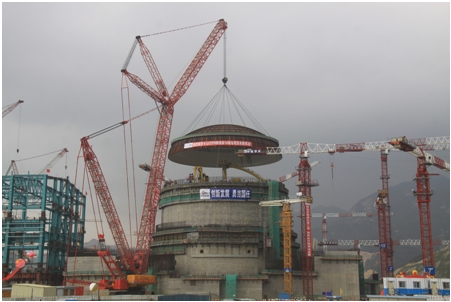In my last post, I discussed the Chinese National Nuclear Corporation and its great power in the Chinese nuclear industry. In 1994, the China Guangdong Nuclear Power Group (CGNPG) comprised of twenty subsidiary companies was capitalized by the Chinese government with nuclear power as its core business. It currently owns and operates two reactors in southern China with six more under construction and four being planned. It is also working on solar, wind and hydro power projects.
The first reactors of the CGNPG were of French design, built by Framatone. Working with the French technology, the CGNPG then developed the CPR-1000 pressurized water reactor which is intended to be the design for many of the new reactors being planned in China. In 2007, CGNPG contracted with the French company Areva for a new European Pressurized Reactor and with Westinghouse for a new AP1000 pressurized water reactor at Taishan. These new reactors are considered to be advanced Generation III reactors.
The Taishan reactor is being built in the heavily populated Pearl River Delta near Hong Kong. It will be the biggest nuclear reactor in the world with three times the radioactive materials of the Fukushima Unit One reactor that melted down in 2011. I have already mentioned that activists in Hong Kong are very concerned with the potential damage that an accident at the Taishan plant could cause. To this date, the Chinese government has not published detailed information on the design of the reactor and safety measure that will be implemented. The reactor will start operating in December of this year.
Greenpeace has reported that there have been a number of reports of problems with the construction of the reactor and that the radiation level around the reactor is already higher than the levels at a nearby operating reactor. The government has cancelled plans for another reactor in the Delta due to massive public protests.
In 2009, CGNPG set up a fund to raise over a billion dollars US for new energy projects. This was the first such fund set up by a state owned enterprise with the approval of the Chinese State Council. The Bank of China, the China Development Bank and other financial institutions will contribute to the fund and be part owners of the resulting projects. In 2013, the company changed its name to the China Nuclear Power Group signifying its intention to operate beyond the Guangdong province.
Here we are again. A huge corporation is building reactors in southern China and to keeping the public informed. Many defects are found in the construction indicating a lax attitude toward safety. An angry public has forced the government to cancel plans for reactor suggesting that social unrest is going to be a problem for future nuclear plans. This pattern is all too familiar. Once again, I have to say that I am afraid that China will not be able to construct and safely operate all the reactors that they have planned.
Taishan reactor:
